The Intel Core i3 530 Review - Great for Overclockers & Gamers
by Anand Lal Shimpi on January 22, 2010 12:00 AM EST- Posted in
- CPUs
The Performance & Power Summary
I’ve added the Core i3 530 to our Bench database, if you want a full comparison of results head over there. What I’m providing here is a subset of our tests to show the 530’s strengths and weaknesses.
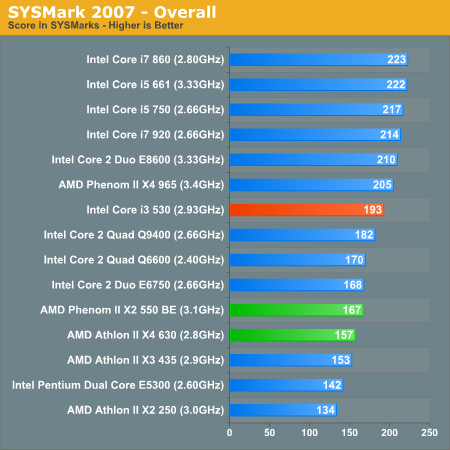
In every single non-gaming test, the Core i3 530 bests the Phenom II X2 550 BE. In our gaming benchmarks the 550 was faster in two out of our 8 benchmarks. In the rest, the i3 took the lead. The Core i3 530 also manages to outperform the Phenom II X2 550 BE while using significantly less power. In the battle of the dual-cores, the i3 wins. AMD needs to fight with clock speed at at 3.1GHz, the 550 can’t muster enough to beat the i3.
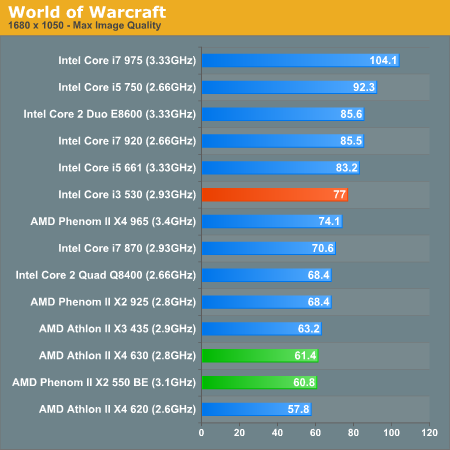
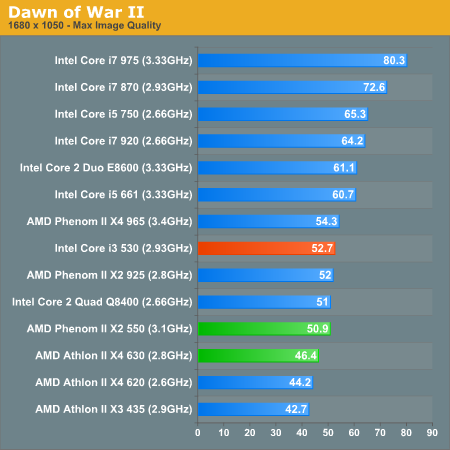
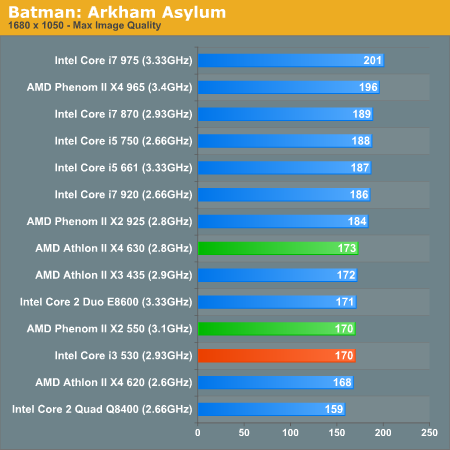
The Athlon II X4 630 comparison is a little more complicated. In single and lightly threaded applications, the i3 is a much better performer thanks to its higher clock speed. The i3's gaming performance is also significantly better across the board. What the Athlon II X4 loses in clock speed, it makes up for in core count. Things like video encoding and offline 3D rendering are almost always faster on the Athlon II X4 630.
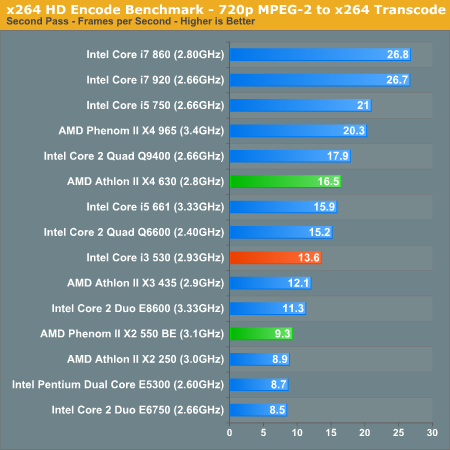
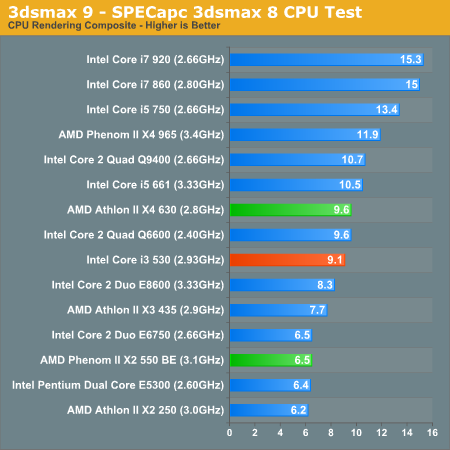
Applications that are bound more by the performance of one or two threads are almost always faster on the Core i3 530. As a general purpose desktop microprocessor or a chip for a gaming rig, I’d opt for the Core i3 530. If you’re doing a lot of heavily threaded content creation, then the Athlon II X4 is the chip for you. If you’re somewhere in between, the choice is up to you. Our Photoshop test has the two processors very close to one another, but with the i3 taking the slight lead.
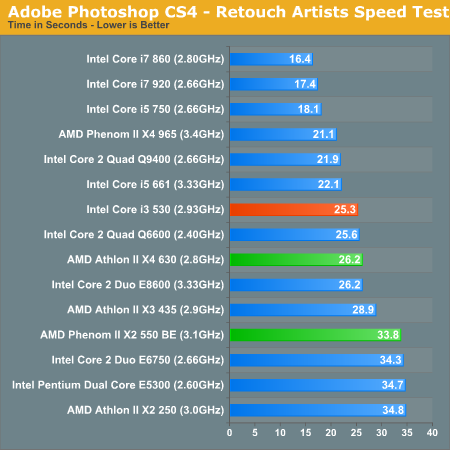
Power efficiency obviously goes to the Core i3 530 thanks to its 32nm transistors.

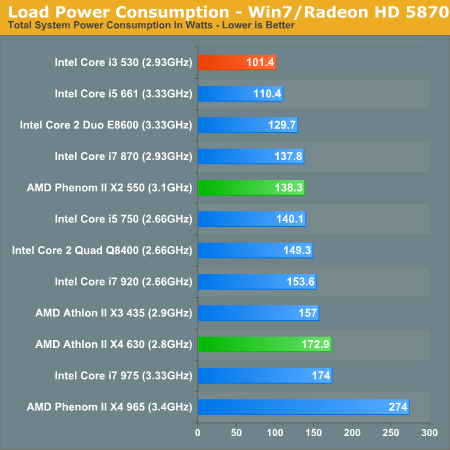










107 Comments
View All Comments
Suntan - Friday, January 22, 2010 - link
Then again, it may just be that those people do have better stereos (or more importantly, better rooms and speakers) then yours.In any case, 99% of this website’s existence is possible because of the tendency for people to try and get “just a little more” out of their electronics…
-Suntan
Suntan - Friday, January 22, 2010 - link
In a word, yes. If your room/components/setup is worth it, then it can make a big difference.Analog output (and no, what you are doing is not LPCM) can compete sound-wise with digital output (either LPCM or bit streaming) if you have a quality soundcard (think Lynx 2B, not anything that says soundblaster) but even then, you lose other digital signal processing capabilities that a good AVR can offer (namely Audyssey Multi-EQ room correction and Audyessey Dynamic-EQ.)
That said, I too think it is a little over exaggerated. Simply because most people really wouldn’t notice the benefit in their situations.
Lastly, I happen to believe that the big flap over LPCM vs. bitstream *is* completely overblown. Ymmv.
-Suntan
Anand Lal Shimpi - Friday, January 22, 2010 - link
I agree that 8-channel LPCM is pretty much good enough. There are issues with players downsampling audio when outputting 8-channel LPCM from TrueHD/DTS-HD MA sources, but to my ears I could never notice the difference.Also remember that the majority of users don't even have 8-channel audio setups. We're talking 5.1 at best, and honestly a huge advantage of these high def audio formats is the support for discrete rear surround channels.
That being said, it's still a valid option to want. Blu-ray players have been able to do it for quite a while, there's no reason we shouldn't demand the same out of our HTPCs. Some users do prefer to keep the decoding on their receiver/preprocessor and for them it's the only option.
Hopefully by the end of this year all platforms will offer it and we can just assume its presence as a checkbox feature.
Take care,
Anand
cmdrdredd - Friday, January 22, 2010 - link
The big problem is some players mess with the audio during the decode and don't output LPCM in a raw untouched format. Bitstreaming means nothing is meddes with, no volume normalization and the like.archcommus - Friday, January 22, 2010 - link
Thanks all for the info, helped clear things up. With my 5.1 system and onboard audio with Windows 7 these days the software decoding and analog output is fine. But I guess in the future with a possible 7.1 system I would at least want LPCM over HDMI. I couldn't imagine needing bitstreaming unless I was building a true home theater.Spivonious - Friday, January 22, 2010 - link
LPCM is decoding the channels and sending them digitally over HDMI.I don't understand the big hype either, unless the decoder in your AVR is much better than the one in software. Otherwise the sound would be the same. I guess it's fun to get the AVR to display "DTS-HD".
blckgrffn - Friday, January 22, 2010 - link
Can we see what the 4ghz power consumption looked like? Was speed step still active? How about the OC'd graphics power consumption?Thanks :)
Anand Lal Shimpi - Friday, January 22, 2010 - link
At 4GHz the i3 530 used 129W under load, up from 101.4W :)I don't remember if speedstep was still functioning when I adjusted the clock multiplier, I believe it was but I'll need to double check.
Take care,
Anand
blckgrffn - Saturday, January 23, 2010 - link
Thank you!I guess it doesn't matter if speedstep was functioning if you could provide the idle power consumption of 4ghz as well.
The information is very much appreciated.
Deaks2 - Friday, January 22, 2010 - link
So were the the overclocking tests done on the Asus or MSI mainboard? Also, would the use of a P55 or H55 chipset affect o/c'ability of this CPU?